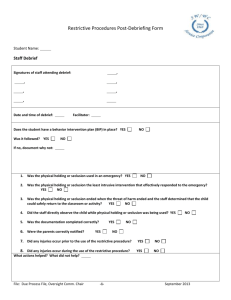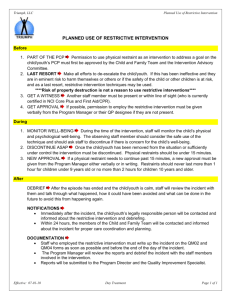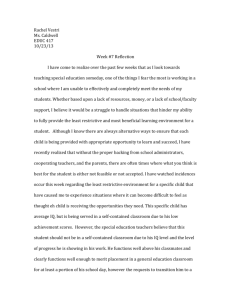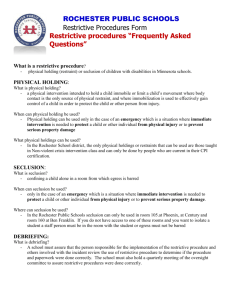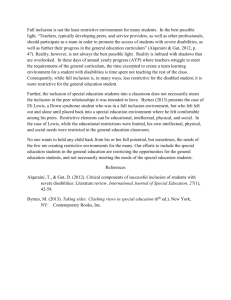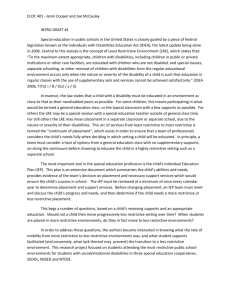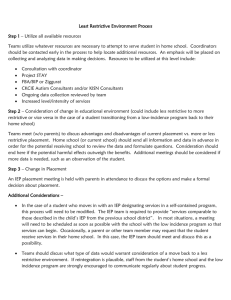Reducing and eliminating restrictive practices in NDIS
advertisement
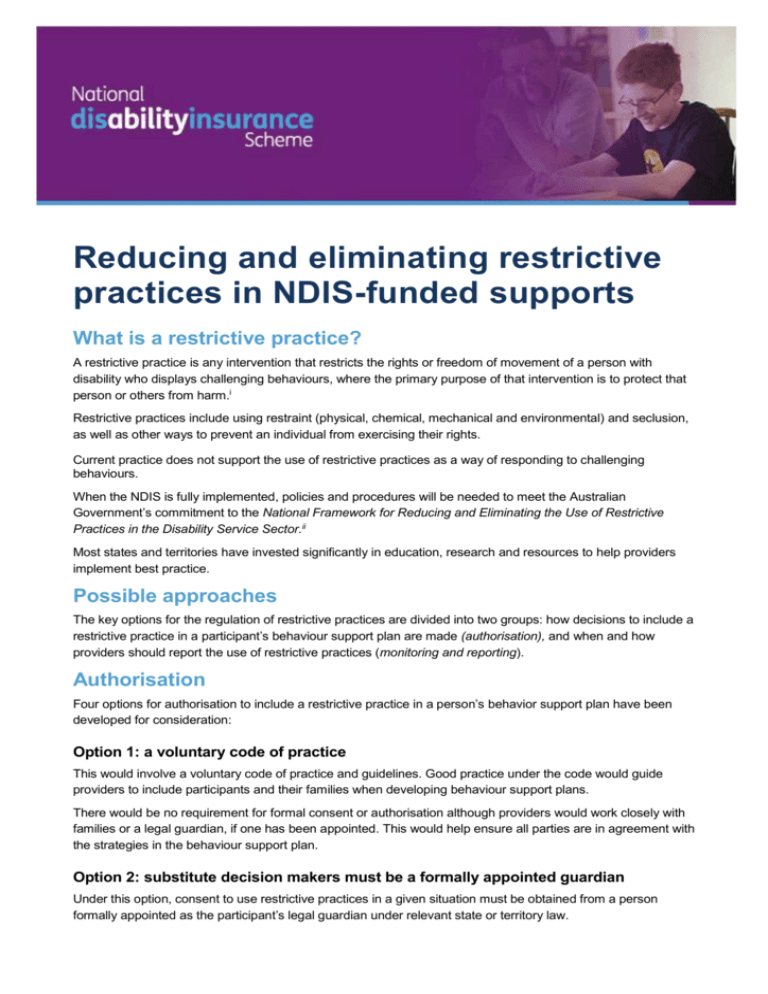
Reducing and eliminating restrictive practices in NDIS-funded supports What is a restrictive practice? A restrictive practice is any intervention that restricts the rights or freedom of movement of a person with disability who displays challenging behaviours, where the primary purpose of that intervention is to protect that person or others from harm.i Restrictive practices include using restraint (physical, chemical, mechanical and environmental) and seclusion, as well as other ways to prevent an individual from exercising their rights. Current practice does not support the use of restrictive practices as a way of responding to challenging behaviours. When the NDIS is fully implemented, policies and procedures will be needed to meet the Australian Government’s commitment to the National Framework for Reducing and Eliminating the Use of Restrictive Practices in the Disability Service Sector.ii Most states and territories have invested significantly in education, research and resources to help providers implement best practice. Possible approaches The key options for the regulation of restrictive practices are divided into two groups: how decisions to include a restrictive practice in a participant’s behaviour support plan are made (authorisation), and when and how providers should report the use of restrictive practices (monitoring and reporting). Authorisation Four options for authorisation to include a restrictive practice in a person’s behavior support plan have been developed for consideration: Option 1: a voluntary code of practice This would involve a voluntary code of practice and guidelines. Good practice under the code would guide providers to include participants and their families when developing behaviour support plans. There would be no requirement for formal consent or authorisation although providers would work closely with families or a legal guardian, if one has been appointed. This would help ensure all parties are in agreement with the strategies in the behaviour support plan. Option 2: substitute decision makers must be a formally appointed guardian Under this option, consent to use restrictive practices in a given situation must be obtained from a person formally appointed as the participant’s legal guardian under relevant state or territory law. This would prevent family members or carers being able to agree to a behaviour support plan that has a restrictive practice for an adult, unless they have been legally appointed as the person’s guardian. Option 3: providers would be authorised to make decisions under specific conditions A specific person or panel of qualified people who work for the provider would be legally permitted to authorise a positive-behaviour support plan that may include the use of restrictive practices. They would be assessed for competence and experience, and approved for this purpose. Option 4: restrictive practices could only be authorised by an independent decision maker This option would require providers to obtain authorisation to use restrictive practices from a decision maker who is independent of the provider. This could be implemented by extending the role of guardianship tribunals (or equivalent administrative tribunals), or by establishing an independent office holder, such as a senior practitioner. Questions Who should decide when restrictive practices can be used, and what safeguards will be needed? What processes or systems might be needed to ensure decisions to use restrictive practices in a behaviour support plan are right for the person concerned? Are there safeguards we should consider that have not been proposed in these options? For providers and employees, what kinds of support are you receiving now from state and territory departments that you think would be helpful if it was available under the NDIS? Monitoring and Reporting There is evidence that monitoring and reporting on the use of restrictive practices is an essential component of a reduction-and-elimination strategy because it makes decision makers (and providers of supports) more accountable for their decisions and options.iii Three options for monitoring and reporting have been developed: Option 1: mandatory reporting for emergency use only (and serious incidents) Providers would be required to report every occasion where a restrictive practice has been used in an emergency, and where the restraint or seclusion was not approved in the individual’s behaviour support plan. This would also include reporting of serious incidents (such as where such use may have resulted in injury or death). Option 2: mandatory notification of all positive behaviour plans with a restrictive practice In addition to Option 1, providers would also be required to report all decisions made to include restrictive practices as part of a participant’s behaviour support plan. Apart from situations that involve emergency use and serious incidents, providers would not need to report on particular instances of restrictive practice use. Option 3: mandatory reporting of each occasion where a restrictive practice is used In addition to the Option 2 reporting requirements, this option would require providers of supports to regularly report on each use of chemical, physical and mechanical restraint and seclusion. This information could be reported by providers via an online electronic system — automated to reduce the administrative burden on providers. 2 Questions Would you support mandatory reporting on the use of restrictive practices? Why or why not? If you support mandatory reporting on the use of restrictive practices, what level of reporting do you believe should occur to provide adequate accountability? (Base your answer on one, or a combination, of the options above). (2014). The National Framework for Reducing and Eliminating the Use of Restrictive Practices in the Disability Service Sector, Department of Social Services, Commonwealth of Australia. ii The National Framework for Reducing and Eliminating the Use of Restrictive Practices in the Disability Service Sector is available at: National Framework for Reducing and Eliminating the use of Restrictive Practices in the Disability Services Sector. iii Scanlan J, ‘Interventions to reduce the use of seclusion and restraint in inpatient psychiatric settings: What we know so far - a review of the literature’, International Journal of Social Psychiatry, vol. 56, no. 4, pp. 412-423 (2010). i 3

